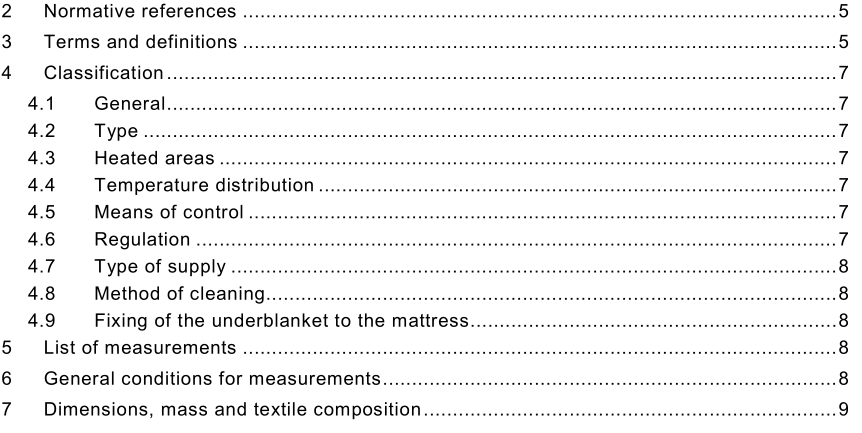IEC 60299-2014 pdf Household electric blankets – methods for measuring performance

7 Dimensions, mass and textile composition 7.1 Dimensions The dimensions of the flexible part of the appliance and the heated area are 7.1.1 determined. The dimensions of a washable detachable cover are also determined in order to 7.1.2 assess the effect of laundering. The appliance is spread out without tension on a flat surface and the length and width are measured. The average values for each dimension are calculated. The dimensions are stated in millimetres (mm), rounded to the nearest 1 0 mm. The lengths of flexible cords are determined. 7.1.3 The measurements are made, as applicable, between – the cord-entry of the flexible part and the control or the transformer; – the control or the transformer and the plug; – two controls. The lengths are stated in metres (m), rounded down to the nearest 0,05 m. 7.2 Mass The mass of the flexible part is measured after the test of Clause 10.
The appliance is conditioned by operating it for 3 h at rated voltage and then the mass is measured. The specific mass is calculated by dividing the mass by the area of the flexible part. The specific mass is stated in g/m 2 rounded up to the nearest 1 0 g/m 2 . NOTE The mass of flexible cords and other external components is not included. 7.3 Textile composition The textile composition of the external surface of the flexible part and detachable cover, if any, is stated. 8 Evenness of temperature The temperature of the surface of the flexible part is measured by means of thermocouples attached to the centre of copper plates having dimensions of 100 mm × 100 mm × 0,5 mm. For overblankets, wraps and duvets the plates are placed under the flexible part. For underblankets the plates are placed over the flexible part. A plate is placed at the centre of the heated area and oriented so that its axes are at 45° to the axes of the appliance. Other plates are placed on the heated area, as shown in Figure 1.
- Previous:IEC 60317-20-2013 pdf Specifications for particular types of winding wires – Part 20: Solderable polyurethane enamelled round copper wire, class 155
- Next:IEC 60243-2-2013 pdf Electric strength of insulating materials – Test methods – Part 2: Additional requirements for tests using direct voltage
- ISO IEC 27050-4-2021 pdf Information technology — Electronic discovery — Part 4: Technical readiness
- ISO IEC 27036-1-2021 pdf Cybersecurity — Supplier relationships — Part 1: Overview and concepts
- ISO IEC 27013-2021 pdf Information security, cybersecurity and privacy protection — Guidance on the integrated implementation of ISO/IEC 27001 and ISO/IEC 20000-1
- ISO IEC 26580-2021 pdf Software and systems engineering — Methods and tools for the feature- based approach to software and systems product line engineering
- ISO IEC 24735-2021 pdf Information technology — Office equipment — Method for measuring digital copying productivity
- ISO IEC 24711-2021 pdf Information technology — Office equipment — Method for the determination of ink cartridge yield for colour inkjet printers and multi- function devices that contain printer components
- ISO IEC 23544-2021 pdf Information Technology — Data centres — Application Platform Energy Effectiveness (APEE)
- ISO IEC 23510-2021 pdf Information technology — 3D printing and scanning — Framework for an Additive Manufacturing Service Platform (AMSP)
- ISO IEC 23127-1-2021 pdf Information technology — Learning, education, and training — Metadata for facilitators of online learning — Part 1: Framework
- ISO IEC 23126-2021 pdf Information technology for learning, education and training — Ubiquitous learning resource organization and description framework
- IEC TR 63304-2021 pdf Methods of measurement of the magnetic properties of permanent magnet (magnetically hard) materials in an open magnetic circuit using a superconducting magnet
- IEC 60183-2015 pdf Guidance for the selection of high-voltage A.C. cable systems
- ISO IEC 19770-11-2021 pdf Information technology — IT asset management — Part 11: Requirements for bodies providing audit and certification of IT asset management systems
- IEC 60305-2021 pdf Insulators for overhead lines with a nominal voltage above 1 000 V – Ceramic or glass insulator units for AC systems – Characteristics of insulator units of the cap and pin type
- ISO IEC 18328-2-2021 pdf Identification cards — ICC-managed devices — Part 2: Physical characteristics and test methods for cards with devices
- BS ISO IEC 15420-2009 pdf Information technology一 Automatic identification and data capture techniques EAN/UPC bar code symbology specification
- BS ISO IEC 19762.5-2008 pdf Information technology一 Automatic identification and data capture (AIDC) techniques – Harmonized vocabulary Part 5: Locating systems
- BS IEC 60860-2014 pdf Radiation protection instrumentation一 Warning equipment for criticality accidents
- ISO IEC 24735-2021 pdf Information technology — Office equipment — Method for measuring digital copying productivity
- ISO IEC 24711-2021 pdf Information technology — Office equipment — Method for the determination of ink cartridge yield for colour inkjet printers and multi- function devices that contain printer components